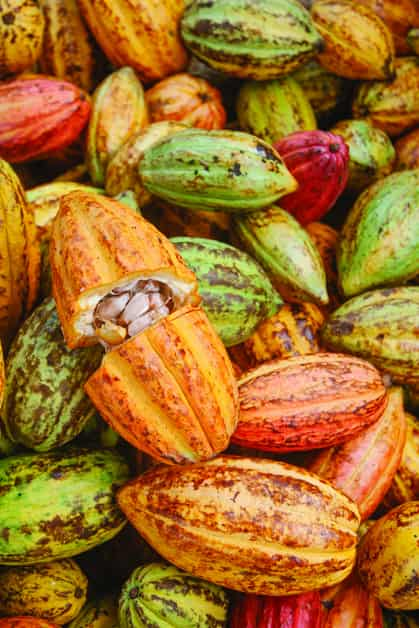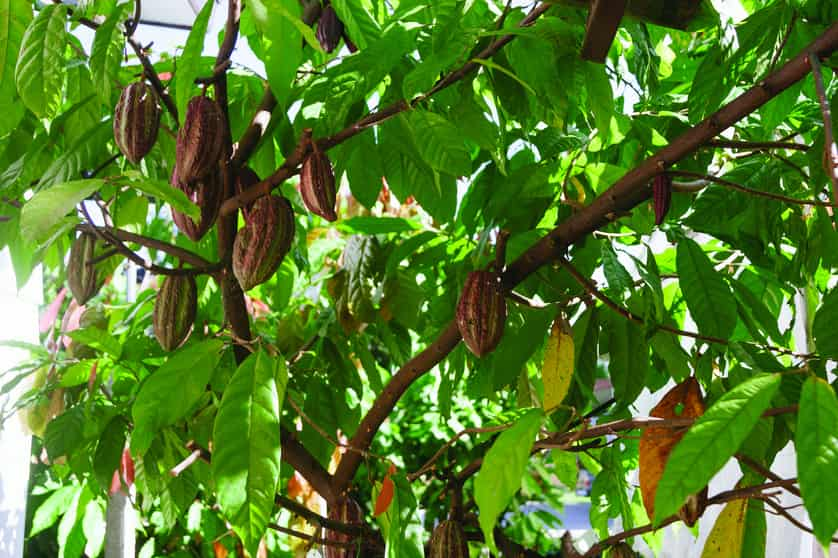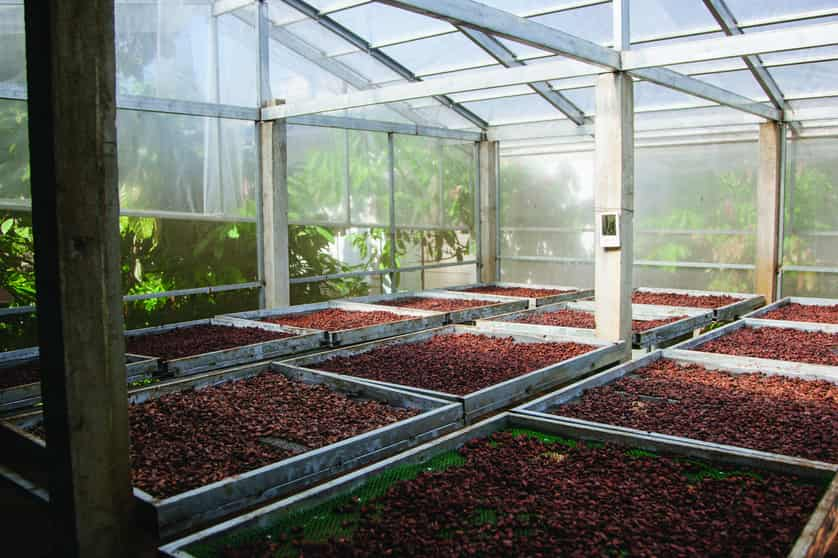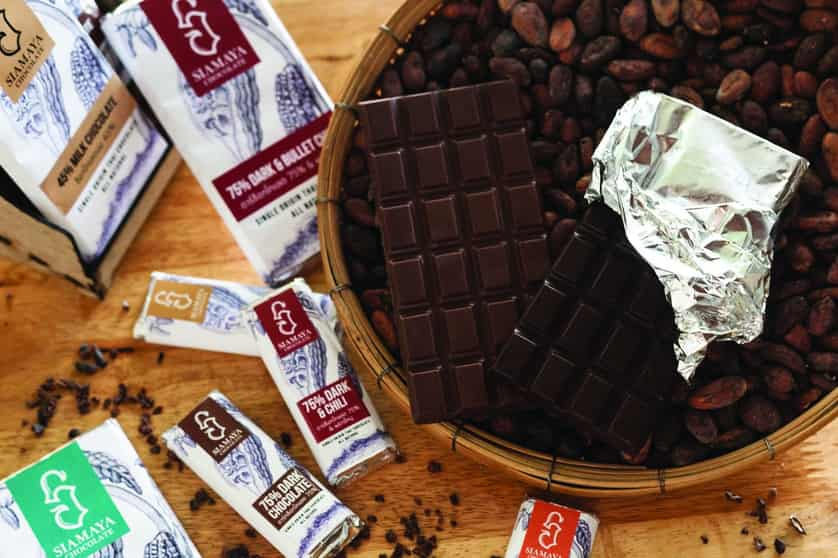I am a huge chocolate fan. I just want to get that out there early so all of you readers can understand my huge excitement about writing this story. You can catch me pretty much any time of the day tucking into a chocolate bar, or two, much to my wife’s dismay. My chocolate habits are so gluttonous they haven’t gone unnoticed by my friends, so much so that one of these friends recently asked me to try out his new chocolate bar, which got me even more excited as it’s made right here in Chiang Mai.

When I arrived at his lab, the smell of chocolate filled my nostrils and my blood pressure grew, anticipating that next coco hit. A machine whirred in the corner and pure 100% chocolate was churning away — conching is the official term — and I couldn’t help but just stare at the silky dark chocolaty mass as I anticipated my first taste.
“The coco beans that we make our chocolate from are grown right here in farms in Chiang Mai you know,” said Kristian Levinsen, co-owner of Siamaya Chocolate. “They are grown by a professor at Maejo University.”
For years I thought I would have to travel to South America to be able to crack open a cacao pod, but to be told it has been right under my nose the entire time…I was amazed. Turns out, Chiang Mai has been experimenting with cacao trees for decades but has only recently succeeded.
Three Chocolaty Decades
“People usually say from bean to bar when talking about locally made chocolate,” said Associate Professor Dr. Sanh La-Ongsri, owner of Mark Rin Chocolate, a family-led cooperative business growing cacao plants. “But we prefer to say from seedling to bar — as we were the ones to breed the only seedling that has survived in this climate so far.” As a lecturer at Maejo University, Dr. Sanh has spent most of his career working on a single breed of cacao to make it grow and produce beans here in Chiang Mai. “I started teaching students about beverage crops over thirty years ago. These included tea, coffee and cocoa — but back at the beginning there was no such thing as growing cacao in Thailand,” he continued. “But I saw the value in chocolate and so I began dedicating more time to researching, breeding and producing cacao plants with the help of my students. It was only three years ago that we bred the perfect crop.”

FYI, cacao is the plant. Cocoa is what the beans become after fermentation and roasting. When de-husked they break down into coco nibs. Coco is the mass you are left with after pressing the coco butter out of the cocoa. But if mixed together, the thick chocolaty liquid is called coco mass. I must admit, even I was confused.
As we talked, his wife Kanokked La-Onsri scooped a spoon of pure chocolate from their small conching machine and topped it with warm water and milk to make a fresh, straight from the bean, hot chocolate. “In the last few years we have started growing our strain of cacao over 2,000 rai of land,” she added. “It’s been named coco hohm hybrid, as it was developed by breeding plants from Peru and the Philippines.” The breed, officially known as IM1, takes the hardiness genes from the Peruvian plants and the good yield and large beans from the Filipino plants.
Although this is the first cacao plant in Chiang Mai, it is not the first in Thailand. In Southern Thailand they also grow cacao plants and sell the beans produced to large chocolate companies. In the south, the beans produced are known as bulk beans — beans that make large amounts of coco and coco butter but are not refined for the taste so need to be mixed with a number of other bean types to make chocolate palatable. “Our cacao breed is the first, and only fine coco producing breed in Thailand,” said Dr. Sanh firmly. “You can roast our beans and make delicious chocolate without adding any other cocoa product.”
The Wider Impact
Chiang Mai’s climate is not one that many would associate with the hot, tropical requirements that cacao plants need. Our rainy season is long but our dry season is longer, our winters can get icy and our summers can scorch even the hardiest of plants. Yet somehow Dr. Sanh’s beans flourished and now Chiang Mai is poised for another agricultural success story.
According to the International Cocoa Organisation (ICCO), roughly 70% of all cocoa production comes out of Africa, with Asia producing around 10% and Latin America another 20%. However, West Africa is slowly reducing its output of cocoa due to factors such as climate change and global market prices. A study by the Centre for Tropical Agriculture claims that if temperatures continue to rise, the world’s two main producers of cocoa — Ghana and Côte d’Ivoire which account for 60% of all cocoa production — would become unsuitable for cacao plants if rainfall decreases and temperatures rise by just 1.2 degrees Celsius by 2030.

Currently, the market’s eyes are on Indonesia as it is the largest cocoa producer in Asia due to its tropical climates and cheap labour. But with strains like our local hybrid, the face of cocoa production could be changed forever. In a report published by the World Agroforestry Centre by Cadburys, most of the world cocoa is grown in a narrow belt just ten degrees north or south of the equator. Chiang Mai sits almost twice that, at 18 degrees north. “We can grow up to 900m above sea level and still get good yield,” Dr. Sanh explained. “All our plants are carefully monitored and grown from seedlings to make sure the strain does not devolve.”
“Cacao plants have a lifespan of seventy years,” said Kanokked as she took me around their garden at their production facility in town. Although just for experimenting and show, these plants were some of the first ever IM1 plants, with their first ever plant standing pride and place with a sign. “Our pods start off green then go a deep red before turning a yellow or orange colour – then you know they are ready to harvest. Unlike other breeds of cocoa, we can harvest all year round and schedule pod collections every fortnight.”
To guarantee the best yield and highest quality, Mark Rin Chocolate ferments all their beans in a post-harvest temperature controlled fermentation station. These stations are free of insects and dust, but remain open air. “There needs to be enough oxygen when fermenting and enough beans in each pile otherwise the fermentation process doesn’t work,” said Dr. Sanh. “We must test every batch for rot and other damage before we roast them or package them for wholesale.” Interestingly, only after fermentation do the beans even begin to have a chocolate scent to them and only when the bean is roasted and separated from its husk can it be ground down to a fine chocolate mass of coco and coco butter that then can be made into chocolate or separated and repurposed.

Slow Local Interest
Dr. Sanh and his wife started their company just a few years ago and are now beginning to sell their coco mass to Japan and France and are also producing a range of cosmetics, soaps and even constipation suppositories from their coco butter. They are certified under the Japanese Frozen Foods Inspection Cooperation (JFFIC) and with the Thai Food and Drug Administration. “Thailand doesn’t have the market for chocolate, for the last few years nobody has been interested so we had to look abroad instead.”
“We were surprised how excited they were when we contacted them about buying beans to make a local chocolate,” said Siamaya Chocolate’s co-owner, Kristopher. “They said we were the first people in Chiang Mai to contact them about making local chocolate. That was our vision. We wanted to make chocolate using only one source of bean so that the unique flavours and notes of that bean could really be tasted. Even high-end brands mix beans from many different sources.”

As we talked in their lab, the scent of chocolate still wafting in the air, he handed me a sample of 75% dark chocolate. “If you try cocoa from one source, you can start to tell that chocolate in fact has a much larger range of flavours and aromas than coffee or wine put together,” said Neil Ransom, another partner in the business. “The problem is that almost all the chocolate we buy in the shops are blends so those unique flavours are lost.” It was strong but smooth, rich but peppery and most curiously of all, a few aromatic Thai notes showed up too. Perhaps it was my own excited imagination but either way, it was a chocolate I’d never tasted before.
Right now Siamaya Chocolate is a very low key production, sold at the Nana Jungle Market and at a few coffee shops around town. “We want to increase our production capacity first, otherwise we will not be able to keep up with demand,” explained Neil.
Dr. Sanh is retiring in the next few years, and it appears that nobody is willing to take his place to teach the next generation about cocoa. “There is nobody with the experience or interest in becoming a professor in beverage crops, so I need to ensure our cacao survives outside of the classroom,” he explained. “The good thing is that because they live for so long, I’ll be long gone before they need replacing – maybe by then more Thais will be interested. This is a boom waiting to happen.”
So for now, chocolate lovers like myself will have to venture a little further to get hold of good, locally made chocolate. But that may not always be the case. A breed like Coco Hohm Hybrid could see another cocoa boom across the world, just as Dr. Sanh predicts, with the crop being grown in places never thought capable before. Yet in reality, the journey of our northernmost coco bean is still in its infancy despite the thirty years it took Dr. Sanh to get here.
For a chocaholic like me, increasing the amount of locally made, high-quality chocolate is very important. Even the World Agroforestry Centre suggests that small-scale local chocolate production may be the answer to the growing decline in the cocoa industry despite the ever increasing demand. So who’s up for a quality cocoa revolution?
Mark Rin Chocolate:
www.cocoathailandcenter.com
Siamaya Chocolate:
Facebook: siamayachocolate




